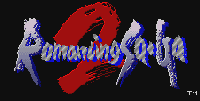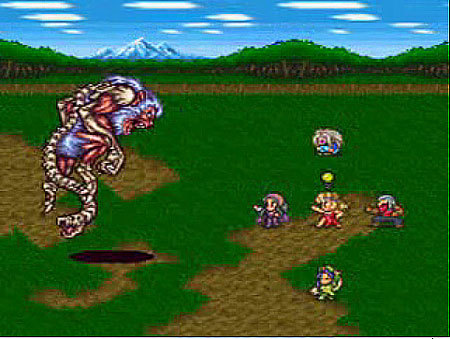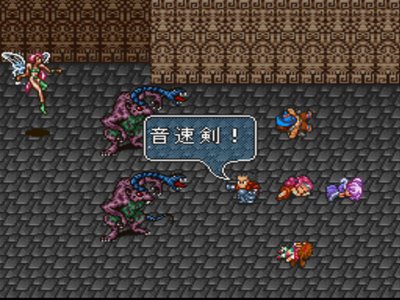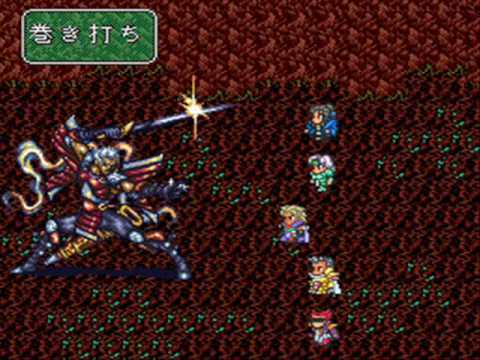|
|

|
PLATFORM
|
Super Nintendo
|
BATTLE SYSTEM
|

|
INTERACTION
|

|
ORIGINALITY
|

|
STORY
|

|
MUSIC & SOUND
|

|
VISUALS
|

|
CHALLENGE
|
Very Hard
|
LANGUAGE BARRIER
|
Moderate
|
COMPLETION TIME
|
20 to 30 hours.
|
|
OVERALL

|
+ Deep and varied skill system.
+ Great variety of enemies and allies.
+ Challenging difficulty.
- Story is rather lean.
- Final boss is just plain nasty.
|
Click here for scoring definitions
|
|
|
A long, long time ago, back when I began studying Japanese in college, I acquired several games via "questionable" means for study purposes. Of the lot, the one that I spent the most time with was Romancing SaGa II. When I came to Japan, one of the first things I did was buy a used Super Famicom and a legitimate copy of this game. I've enjoyed it many, many times since then.
As with most games in the SaGa series, RS2 places gameplay over plot in terms of importance, but what plot it has goes as so: ages ago members of an ancient race sought to preserve their golden age forever via magic. Something went awry, however, and demons flooded the world. Only through the efforts of the seven greatest heroes of the age were the demons turned back, but at terrible cost. The Seven were lost in the final battle and the ancients themselves soon vanished from the earth. Among the civilizations that arose from the ruins of war there was a legend, a promise that in times of trouble the Seven Heroes would return.
No one ever imagined that they'd be the ones causing the trouble.
This is the situation as the game starts. Monstrous armies, commanded by the Seven, have conquered large stretches of the continent. One of the last holdouts, the kingdom of Avalon, has been chosen for a special destiny. The player takes command of the imperial dynasty as it fights the Seven over the course of several centuries. Apart from the very beginning and the very end of the game, the Emperor/party leader is not predetermined, and might be chosen from any of the game's thirty-three character classes.
 A bright idea?
A bright idea?
|
|
As it lacks a definite main character for much of the game, RS2's story is often a little vague and very NPC-oriented. The game progression is non-linear, so at any time there may be a choice of three or four areas to visit. In fact it is technically possible to cross the entire continent fairly early in the game if one is lucky and quick to run from monsters, though quests in later areas usually come with prerequisites. More time is devoted to exploring the motives and history of the Seven than anything else, which results in a deep and layered history of the world through which player travels.
RS2's soundtrack is a joint production by Nobuo Uematsu and Kenji Ito, and for all the limitations present in the MIDI format the battle themes and scenic medleys are worth listening to. The final boss theme is one of the best of its generation, in this reviewer's opinion. Unfortunately the early series soundtrack collections are difficult to find these days.
Battles are the most important part of any SaGa game, and here is where RS2 really shines the most. This is the series entry that introduced Life Points (LP), special formations, and the "glimmer" system where attacks are learned mid-battle (with a little light-bulb over a character's head), but for all these rather radical changes to the standard turn-based combat everything goes as smoothly as if the systems had been developed over the course of several games.
 Giving the shout-out
Giving the shout-out
|
|
Battle graphics deserve a special mention as well. The sprites for each class are visually unique and have a variety of poses (far more than in any of the SNES Final Fantasy games, in fact). These sprites cover all actions outside of battle as well, with no super-deformed characters running around towns. The monster designers did their job well, with a wide range of monster types available. Instead of straight palette swaps, monsters of the same family might share a base sprite but with its orientation reversed, equipment added, visual effects changed, or any number of other alterations so that monsters may look similar but not identical-but-for-a-paintjob.
A very important part of the game's dynastic aspect is the inheritance system. Whenever a battle is lost, be it through full-party wipeout or Imperial LP-depletion, a new Emperor must be chosen from four candidates provided. The new Emperor will inherit all skill levels from his or her predecessors, on top of what is normal for that character's class. Party members may be proficient in any of five weapons categories or three out of six magic types. As base stats are locked, skill level bonuses (and the ability points they provide) are the main thrust of character development. By sheer force of accumulation, later Emperors are proficient in every form of combat imaginable.
Another result of the inheritance system is that, except for the very beginning and the very end, one will never see a game-over screen in RS2. The penalty for defeat is that one will have to re-organize and re-equip another party. No items are lost, though any new attack skills learned that generation will have to be rediscovered. There's also one scenario whose outcome changes if the party is wiped out.
 Who's the hero here?
Who's the hero here?
|
|
This is the only thing keeping RS2's difficulty at "Challenging" instead of "Insanely Difficult". Given the relatively light penalty for failure, the developers seem to have decided that players should see full-party wipeouts as often as possible. While character advancement is largely tied to enemy difficulty, monster rank advancement is tied to the number of battles entered -- even the ones the player runs away from. Because of this, enemy levels quickly outpace the player's in the middle of the game, only to even out towards the end.
One last thing that makes RS2 stand out is the breadth of its magic system. Aside from the basic attack and healing spells, there's a variety of defensive spells as well as such things as invisibility, superpowers, magically crafted weaponry, and even the ability to turn a character into a wraith for one battle. On the physical side the weapons techniques are quite varied as well, many of them useful in ways besides dealing damage. Access to the higher level spells and techniques makes the end-game much less difficult, but still quite challenging.
In conclusion, this is a game for people who like combat and battle systems, but not those who hold plot above all else. The game's varied spell and skills list, as well as the wide freedom to explore, let the player take on the world in any way he or she might fancy. My final say is this: Should this game be announced for a remake, and I do not own the system for which it is to be made, then I will buy that system solely on the strength of this title. I can think of no better endorsement than that.
Review Archives
|









